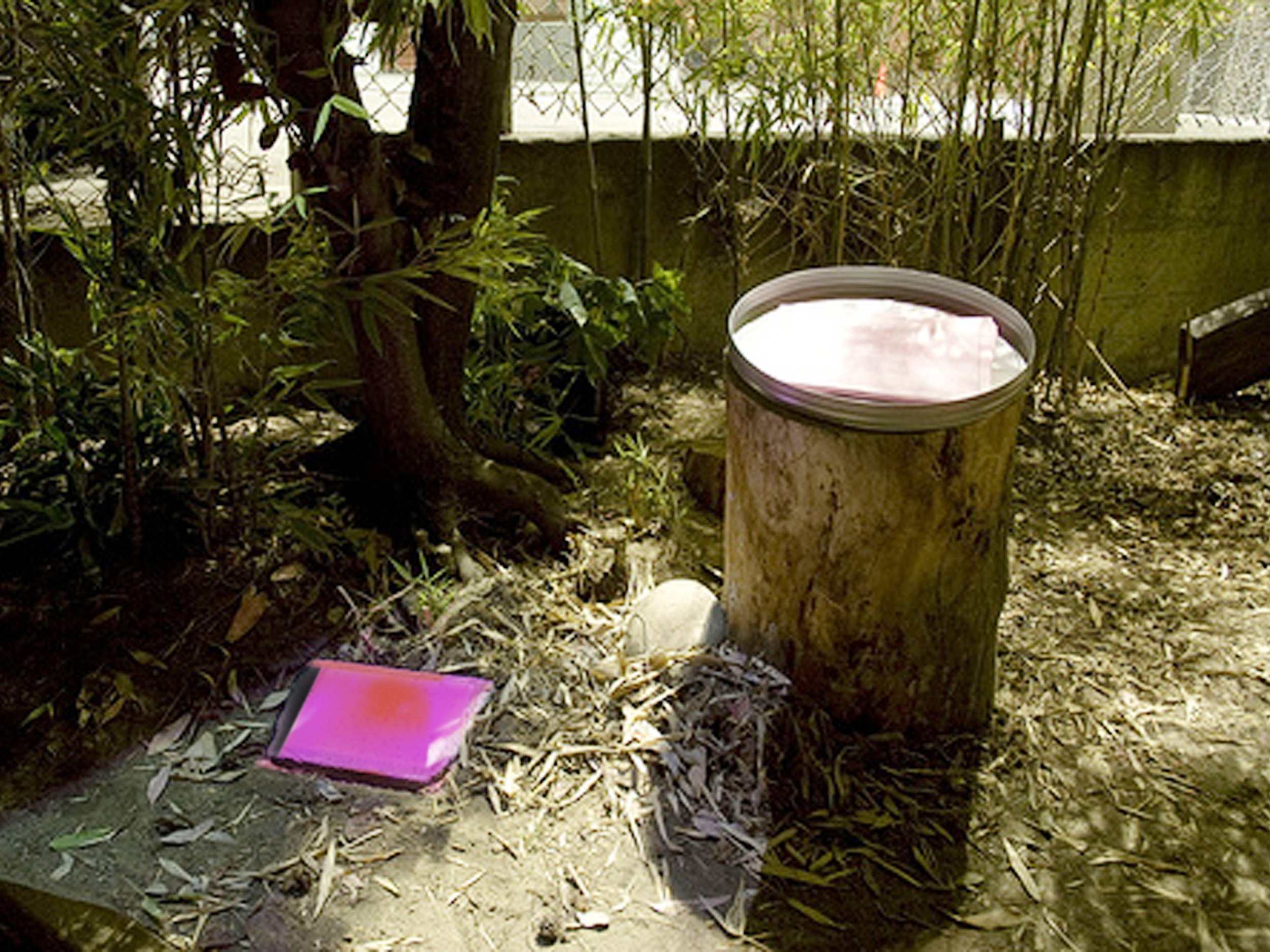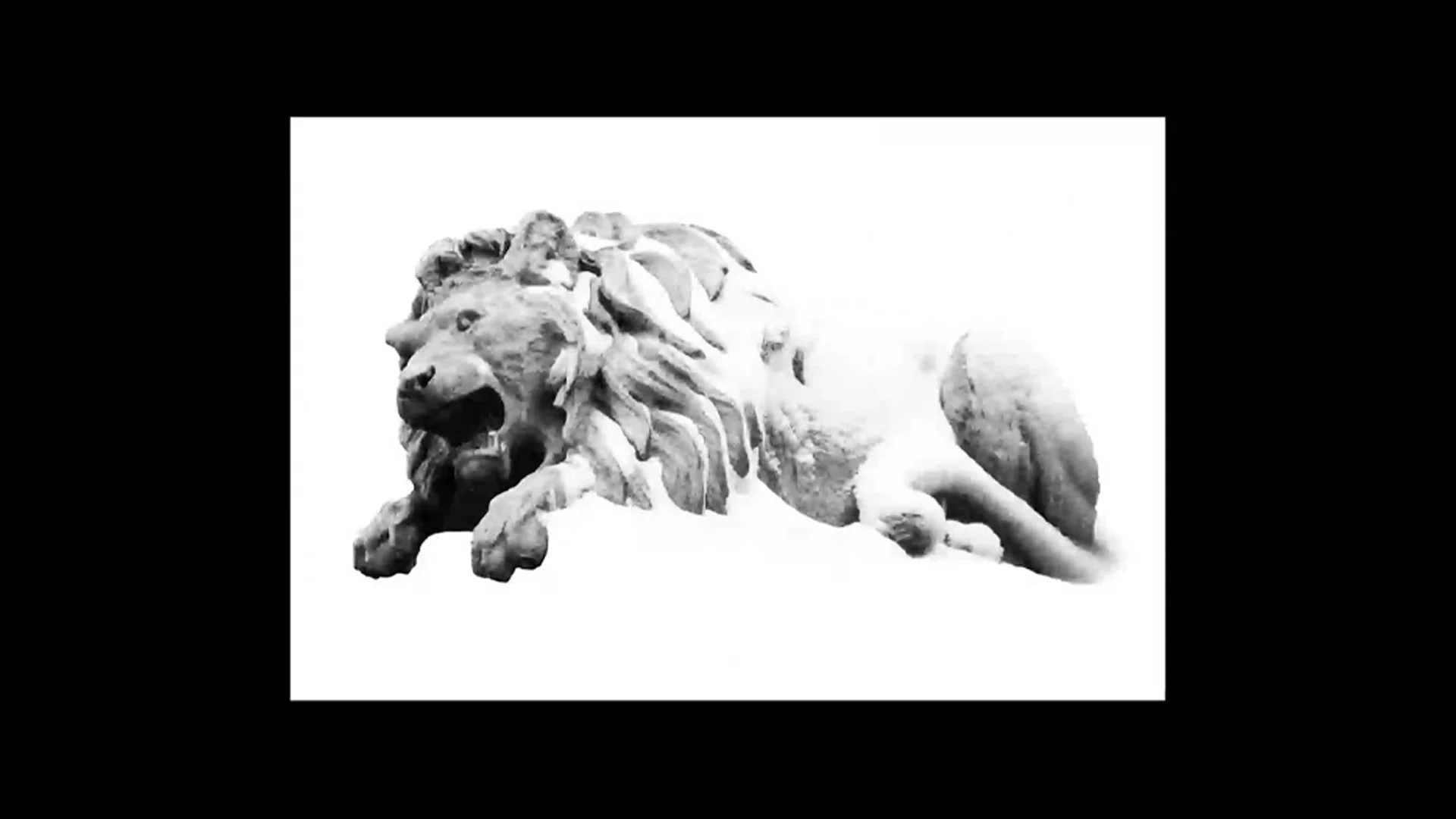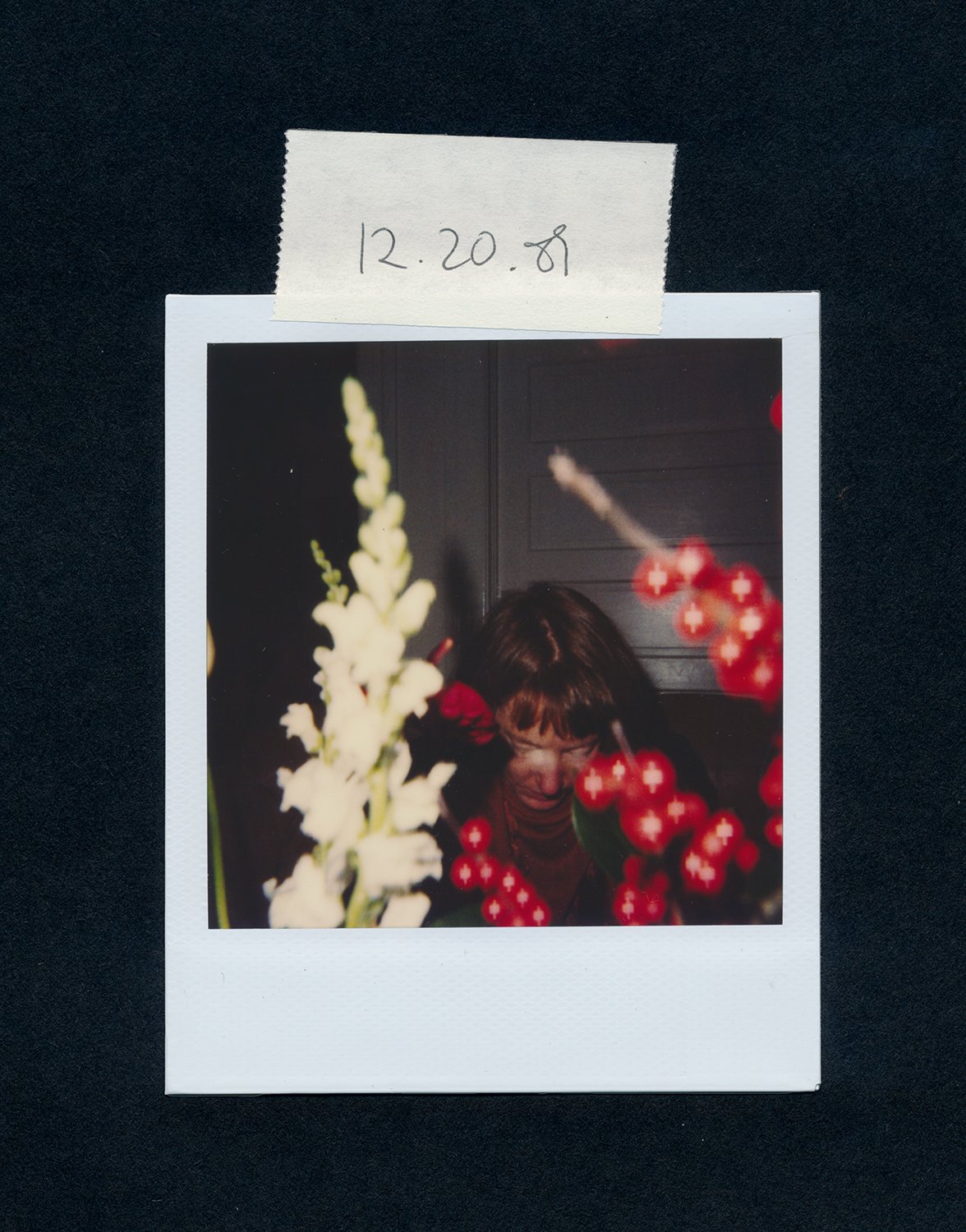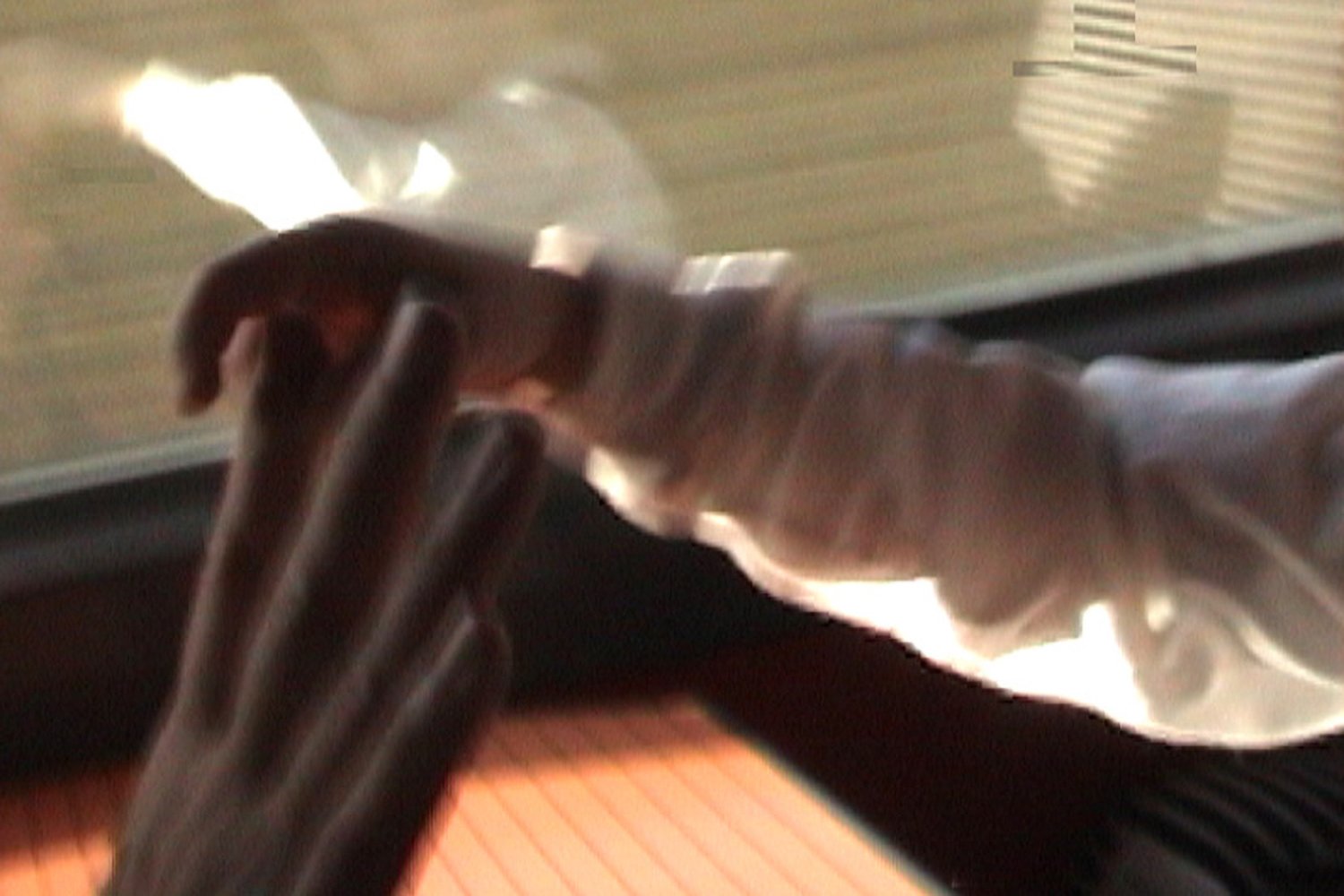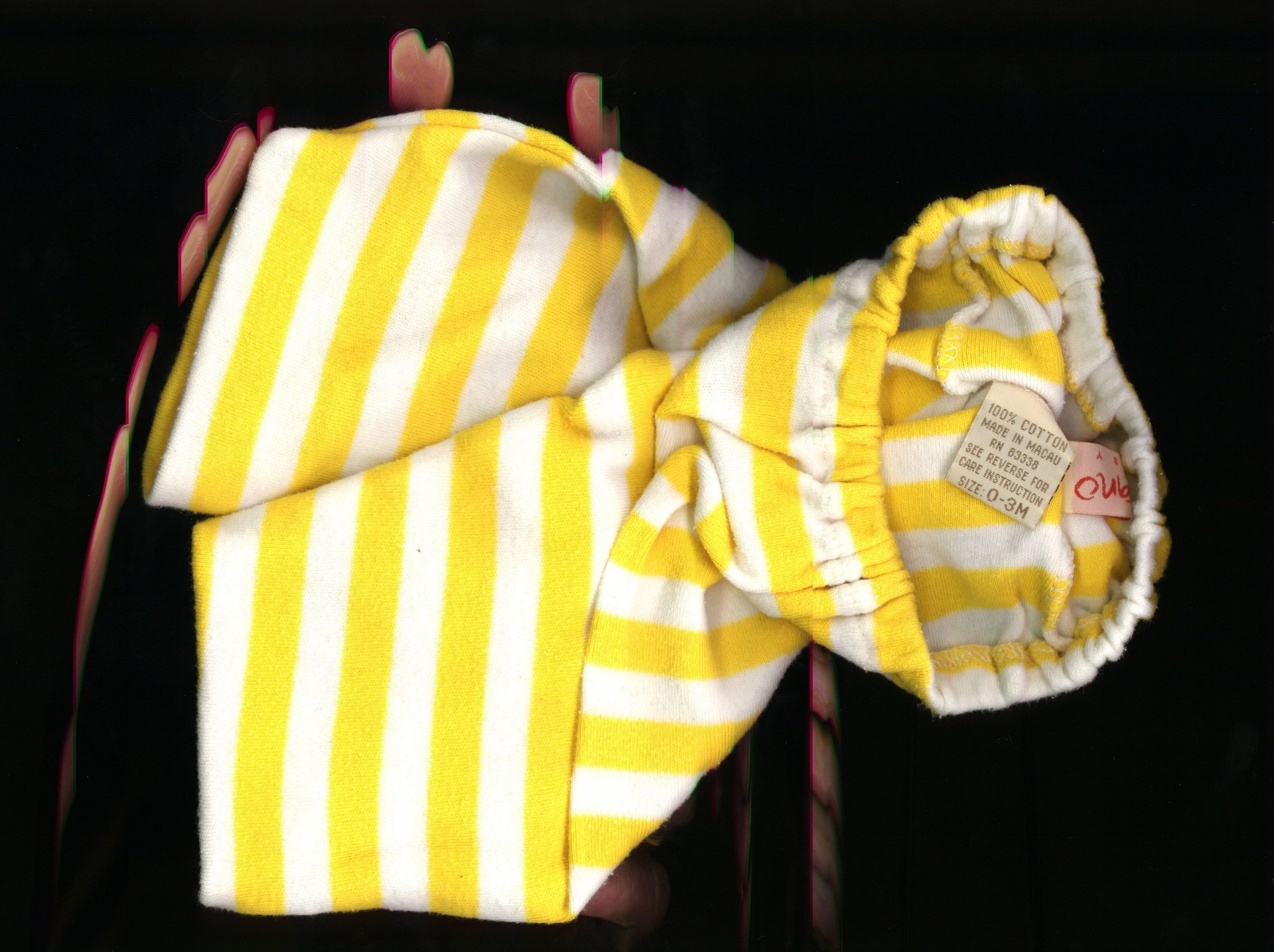TIME DILATIONS
(excerpt)
After Broken Blossoms
A piece made by exposing peony petals onto a roll of 16mm film— in a film changing bag with a flashlight. The resulting film, transferred to digital, was projected onto a stone in the garden outside the gallery. DW Griffith’s 1919 silent film Broken Blossoms was the jumping off point for a broadsheet text take-away.
2006
digital projection, stone, printed takeaway
Atlas of Trembles
Some of my interests in traditions of landscape cinema, improvisational real-time editing and digital-to-analog glitches, manifest to make transparent an archiving and representation process, an ongoing road movie.
I have collected 16mm film footage and video from travels around the US: a ride down the Cuyahoga River, shots of Civil War battlefields, walks through fields of growing flowers, grain and fruit, water systems, rail systems, malls and parades, and kudzu growth in Mississippi.
Over the years I have taken material from this archive to make other work. In 1995, C to C: Several Centuries After the Double Slit Experiment and Inside the Gold Frame, Outside the Car Window were made from this archive.
1984 - ongoing
(excerpt)
Back, Back Again to Paris
in collaboration with Etel Adnan
Etel and I had originally conceived of this collaboration to show as part of the retrospective of her work at the Wattis Institute. When the project was rejected, we took the work to the sidewalk outside the Wattis in the form of a broadsheet.
Only sentences from Etel’s book Paris When It’s Naked, 1993, that contained the word Paris, were read into the speech to text program Dragon Dictate. Etel then intervened into her earlier, now “translated” text. This block of text became a broadsheet takeaway. The accompanying video is made up of mistranslations of the word “Paris,” outlines of Etel’s paintings on view inside the Wattis, as well as cinematic moments. The video was originally viewed via a scan code link on the back of the broadsheet.
2013
broadsheet, scan-code linked video
Bathing
in collaboration with composer David Jaffee, who wrote a libretto, no words, for female voice, performed by Emily Bezar
Improvisation for video and singer. The singer performs live in her bathrobe. Simultaneously, but purposely not in direct sync, the video plays on the video monitors. The video—of a man bathing, the sound of water and his humming, mixes with the live performance. The singer moves about the space. Bubbles fall from a bubble machine above the set.
in collaboration with composer and performer Anne Hege who performs live, blowing bubbles and singing through a straw
Improvisation for video, iPads and singer. The singer performs next to the screen, iPads are held around the theater, playing bubble sounds and video.
1994, 2025
Daily Notes
A diary of daily life in my apartment, took a Polaroid daily for a year.
1989 -1990
Polaroids
Endpapers (and books)
Book-ending patterns create small breath portals at the beginning and end of a book. The video was projected inside a book in a library.
Also installed in libraries around San Francisco is a set of five bookmarks, made in collaboration with Denise Newman, to celebrate our friend Etel Adnan’s 94th birthday on Poem in your Pocket Day, 2019.
I made marble paper using water collected at in the canal under Paludo Sant’Antonio Bridge in Venice as part of Gestures in Search of Missing Tenderness, 2019.
Inspired by bookplates, inscriptions inside books that show the name of a book’s owner, I made an Ex Libris stamp when commissioned by the San Francesco Arts Commission for the citywide Passport Book project in 2017. This passport book is a way for people to collect local art and features artists working in their San Francisco neighborhoods. Ex Libris is used as an inscription to show the name of the book's owner. It is both a pun for people to be stamping their passport books with this ownership phrase, and a way to honor the history of books and my local bookstore.
2010 -2019
digital video, bookmarks, ink, stamps, paper
(excerpt)
(excerpt)
Fog
A film projected on a blank billboard in San Francisco’s fog belt, the Sunset District, as part of an evening of fog events curated through The Annex Gallery.
2014
16mm transferred to digital
(excerpt)
In Search of Lost Baths of Constantine
This is a digital scratch piece shot in the South of France near the ruins of Constantine’s Baths. Working with the pixel break-up to draw out the tile patterns at the bottom of the pool, I improvised live out of the timeline while outputting from the computer—scrubbing through the timeline—exploring in my movements, as my son also explores, the water, and light.
There is an erratic relationship between the length of my gesture and speed of movement through the timeline, accessing the material live in the hard drives is unpredictable.
2001
digital video, multiple screens
Intersection
One of the earliest Site Light Exposures made upon my return to San Francisco. I exposed 16mm film to the intersection outside of where I live. The final video, made recording a live performance on a film to digital transfer machine, is a meditation on the intersection of film and digital materials and the two cross streets that define my address.
2003
video
Off the Tracks
Shot on a train in France the piece explores different forms of time, from the linear time of train travel, to the biological unfolding of physical and cognitive development of the child through the acquisition of language and concepts of counting; the movement from the realm of the mother to the realm of the father.
As the TGV screams through the French countryside the landscape becomes a blur. My son, looking at the small camera screen, asks if we are going “off the tracks”?
I worked with the pixel shapes of image break-up to articulate the planes of the horizon line, redefining the shifting space of landscape and the history of framing landscape, here through the window of the train.
This landscape image then collapses and expands further as I improvise with it while digitizing. For each theme/time pressure investigation, I improvised three times with the same material and put each improvisation back to back. Thus even the linear and chronological time is expanded and collapsed through fast-forwarding and rewinding. Each three-part improvisation is then looped for the triptych; each screen varies in length so that the relationship between the screens is always shifting.
2001
digital video triptych
Please turn out the lights
in collaboration with Zach Iannazzi
Originally conceived as a performance that would articulate the space of the SFMOMA film screening space, where we would amplify the sounds of the theater itself and the movement of the screen maskers.
Changes at SFMOMA in relation to film programming and Covid made it necessary to change our venue to The Lab, a screening facility without the formalities of a theatrical space.
We re-thought our idea, and decided to revisit and write into Hollis Frampton’s A Lecture, a famous performance in front of a blank screen. We wanted to discuss contemporary cinematic issues riffing off his text. We explored how Covid has shaped and changed cinema viewing and our relation to screens.
2022
broadsheet, pipe cleaner, red and blue filters, scented candles
Requiescat
This 100-foot roll of film contains 1000 X's. Each "X" scratched into the film is a prayer or a wish for the repose of a person killed in Iraq. In transferring the film to digital video, I did not etch an "X" for each death into the film emulsion. Instead, I punched the transfer machine each time I saw an "X" pass in real time. This new gesture marks each death anew, with a skip or glitch or polarity change.
2006
16mm black leader
Scans 1 - 55
In conversation with Mary Kelly’s Post-Partum Document, this is a record and archive of my son’s growth in his first year, also of my community and the generous tradition of welcoming a child into the world with gifts of clothes. I scanned the gifted clothes after he outgrew them. Labels on the baby clothes tell a parallel story of global production.
1997
scans to digital video
Six Shooter
Explores the mythos of the American West projected into the landscape. Following my son in his cowboy costume in an abandoned Western set, the video is both a critique and a study of masculinity, power, and the myth of the loner and the outlaw—an ode to John Ford and Howard Hawks.
2003
video
(excerpt)
Study in Choreography for Camera Remote
Shot after returning to San Francisco from Paris in 2000, this is a small, seven-day excerpt of a year-long project in which I recorded my daily sweeping after breakfast.
I think of this piece as a collaboration across time with Maya Deren and her film, Study in Choreography for Camera from 1945.
Deren is thinking about the collapse of space and about the vocabulary of editing, in which she combines spaces. Here, I collapse the image on top of itself, thinking about time, using the remote in both shooting and editing.
2000
video
Twilight’s Last Gleaming
I am concerned with the current political climate, the potential for war in the Middle East. As my young son tries to understand what nationhood means and what war means, I think about how artists in the past engaged in conversations about war and how I can speak in my own work.
I take as my point of departure footage from a July 4th barbecue. The time ordering of this footage was manipulated three ways: by the changing amplitude of Jimi Hendrix's "Star Spangled Banner,” by John Phillip Sousa's changing pitch in "The Stars and Stripes Forever," and by improvisations that I performed as I moved through the timeline of my material.
I made a flag pattern with the stars and stripes from the American flag, making a grid of the stars and horizontal blocks with the thirteen stripes. I play the material through these patterns, down-sampling the usual size of the image from 720 x 480 pixels to a small grid of 5 x 6 pixels for the stars, and a small block for the stripes. This filtering system plays the average color of that portion of the frame, exports it through the stars or stripes pattern, rather than playing the whole image. (An extreme close up—zoomed way into the image, so that it is no longer a "picture" but just the average color of that "image gesture" like seeing the grain blown up, but here it is the pixel color averages from a small square or block of the whole image.)
Through this process I have embedded my material across time and history, in conversation with these two artists, Hendrix and Sousa, and their very different relationships to the martial. Although we do not hear Hendrix or Sousa, their presence is embedded in the image and although we do not see the image, its color properties are embedded in the flag pattern.
2002
digital video triptych
